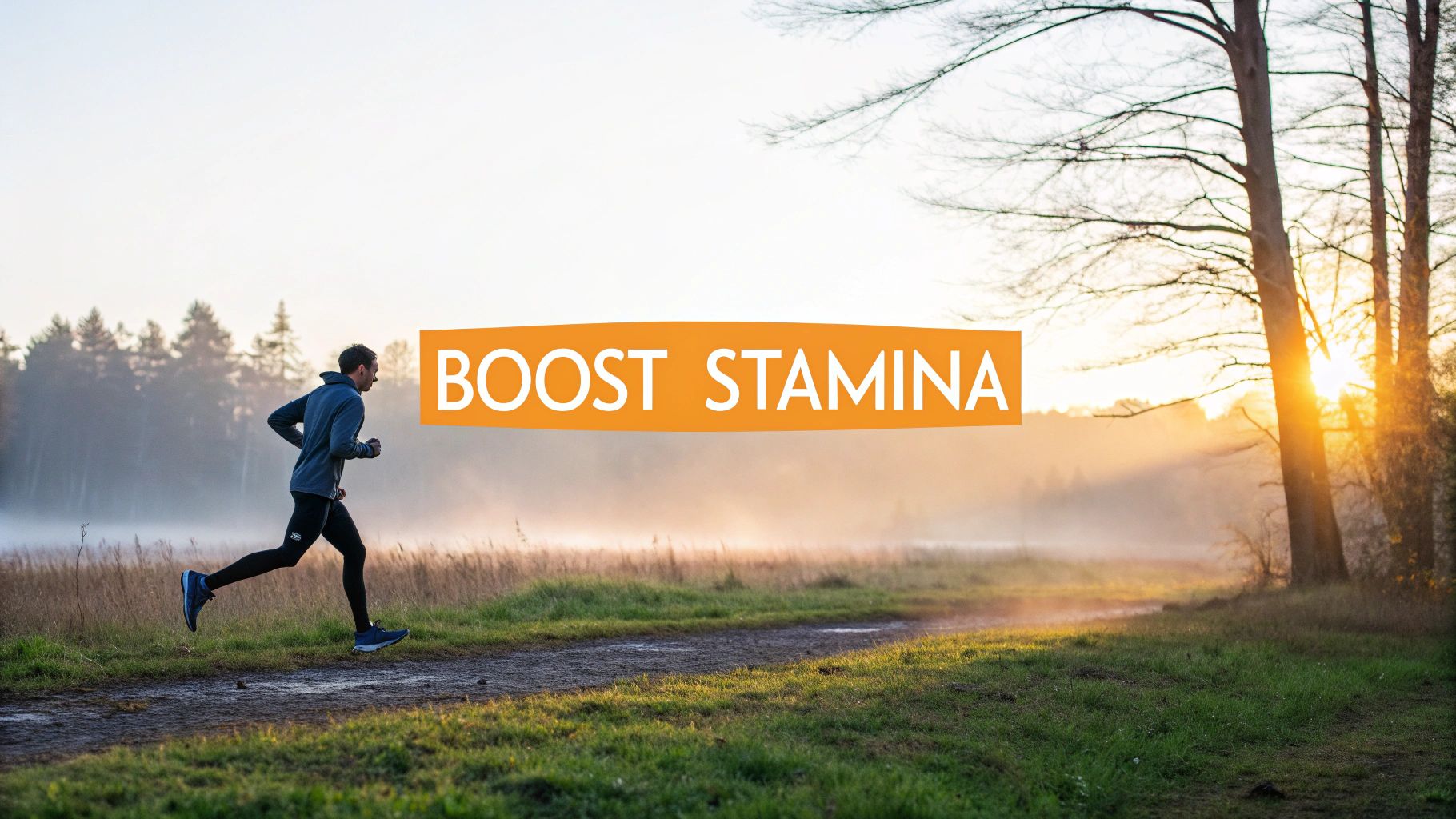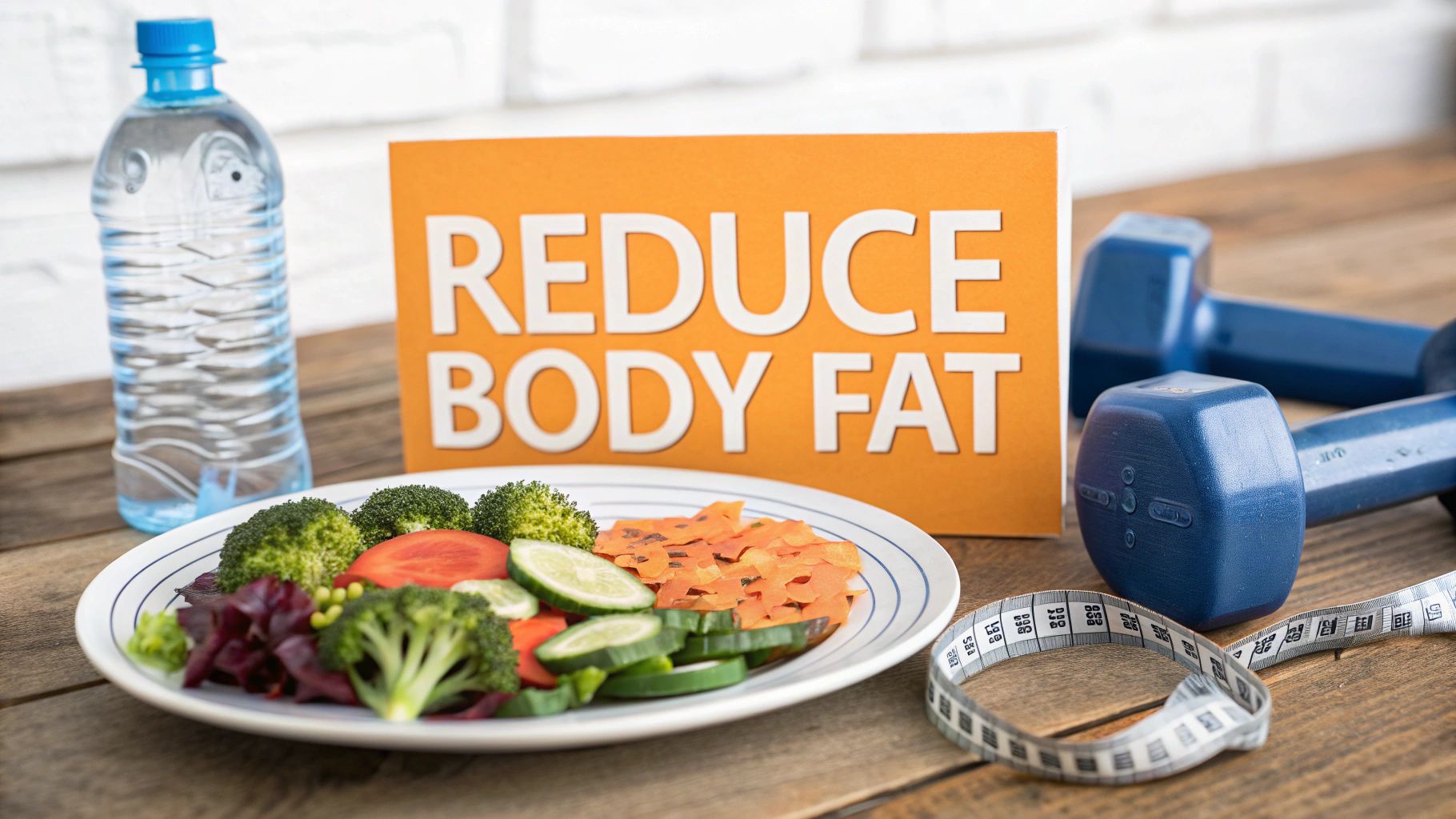To build real, lasting stamina, you need a smart, consistent blend of the right exercise, supportive nutrition, and dedicated recovery. It’s about so much more than just grinding harder in the gym. The real goal is to make your body fundamentally more efficient at producing and using energy.
When you combine aerobic conditioning, strength training, and smart lifestyle habits, you’re not just chasing a temporary boost—you’re building a sustainable foundation for endurance that sticks.
Why Natural Stamina Is Your Ultimate Advantage
Before we jump into specific workouts, let's get on the same page about what "building stamina" actually means. We're not talking about a quick fix or some magic supplement that promises the world overnight. The goal here is to create a sustainable system where your body becomes a powerhouse of efficiency, capable of performing work for extended periods without breaking down.
Learning to improve your stamina naturally is about rewiring your body from the inside out.
True endurance is like a symphony of biological processes all working in perfect harmony. It’s built on three core pillars that support and amplify each other, creating a powerful feedback loop that steadily raises your overall capacity.
The Three Pillars of Lasting Endurance
- Smart Exercise Protocols: This is way more than just logging endless miles. It’s a calculated mix of cardiovascular training to improve oxygen delivery (VO2 max), strength work to make your muscles more efficient, and high-intensity intervals to shatter your performance ceiling.
- Powerful, Fueling Nutrition: Your body needs the right raw materials to perform and recover. That means getting enough complex carbohydrates for sustained energy, lean proteins for muscle repair, and micronutrients that fight inflammation and support metabolic function.
- Strategic Recovery and Lifestyle: Stamina isn’t just built in the gym; it's solidified during rest. Deep sleep, proper hydration, and stress management are the non-negotiable glue that allows your body to adapt, repair, and come back stronger than before.
Think of your body like a high-performance car. The engine (your heart and lungs) needs to be powerful, the chassis (your muscles) must be strong and resilient, and the fuel (your nutrition) has to be premium grade. Neglecting any one of these will absolutely limit your performance on the road.
Understanding how these elements are interconnected is your roadmap. Each section that follows will break down one of these pillars, giving you actionable steps to build natural, lasting stamina for everything from crushing your workday to hitting a new personal best.
Build Lasting Endurance with Strategic Exercise

If you really want to boost your physical capacity, vague advice like "just run more" isn't going to cut it. Building endurance that actually lasts requires a smarter, more structured plan. It's about combining different types of training to hit every one of your body's energy systems.
The bedrock of any solid endurance plan is steady-state cardio. This is your long, slow stuff—jogging, cycling, or swimming at a consistent pace where you could still hold a conversation. These longer sessions are absolutely essential for building your aerobic base, making your heart more efficient, and teaching your body to tap into fat for fuel.
The Power of Intensity Variation
While that steady-state work builds your foundation, it’s High-Intensity Interval Training (HIIT) that will shatter your performance ceiling. HIIT is all about short bursts of all-out effort followed by quick recovery periods. Think a 30-second sprint, then 60 seconds of walking, repeated for 15-20 minutes.
This method is incredibly effective for jacking up your VO2 max—the maximum amount of oxygen your body can use during intense exercise. A higher VO2 max means you can push harder for longer before hitting the wall. Just slotting one or two HIIT sessions into your week can make a huge difference in your stamina. For more specific running tips, check out our guide on how to improve stamina for running.
Why Strength Training Is a Game Changer
So many people sleep on strength training when they're trying to build stamina, but it’s a critical piece of the puzzle. Stronger muscles are more efficient muscles. Plain and simple. They demand less oxygen and energy to do the same amount of work, meaning you fatigue much, much slower.
You'll want to focus on big, compound movements that recruit multiple muscle groups at once:
- Squats: The king for building powerful legs and a rock-solid core.
- Deadlifts: Develops total-body strength and incredible posterior chain endurance.
- Push-ups: Builds upper body and core stability that translates to better form.
Adding two to three strength sessions per week not only makes you more fatigue-resistant but also helps bulletproof your body against injuries by strengthening the muscles and connective tissues around your joints.
One of the biggest hurdles to building stamina is simply not moving enough in the first place. Physical inactivity is a global issue, with about 31% of adults failing to meet recommended activity levels. This reality just highlights how important a structured exercise plan is for counteracting a sedentary lifestyle and improving endurance. By blending these three training styles—steady cardio, HIIT, and strength work—you create a balanced, powerful plan for building stamina that sticks.
Fuel Your Body for Peak Stamina and Performance
Exercise breaks your body down, but smart nutrition is what builds it back up stronger than before. The food on your plate is the literal fuel that powers your endurance, repairs hardworking muscle tissue, and gets you ready for the next challenge. When you start thinking about how to improve stamina naturally, the first place to look is your kitchen.
Your main energy source comes from complex carbohydrates. Forget the myth that all carbs are the enemy; for sustained performance, they're absolutely essential. Foods like oats, brown rice, sweet potatoes, and quinoa release energy slowly and steadily, which helps you sidestep that dreaded "crash" halfway through a long run or intense workout. A good rule of thumb is to have a carb-focused meal a few hours before a demanding session to make sure your energy stores are topped off.
Beyond Carbs: Macronutrient Synergy
While carbs are the immediate fuel, lean protein and healthy fats are just as critical for building long-term endurance. Protein is the foundation for muscle repair. Getting enough of it from sources like chicken, fish, beans, and lentils helps your body recover faster and become far more resilient to fatigue.
Healthy fats, found in foods like avocados, nuts, and olive oil, are crucial for hormone production. They also serve as a secondary, long-lasting energy source, which your body taps into during lower-intensity, longer-duration activities.
Foods That Supercharge Your Stamina
Some foods offer unique benefits that can give your endurance a real edge. Beetroot, for example, is packed with dietary nitrates. These compounds can actually improve your muscle efficiency and reduce the amount of oxygen you need during exercise, allowing you to push harder for longer.
Diet and targeted supplementation are key to improving stamina because endurance relies on efficient energy use and muscle function. For example, research shows dietary nitrate from sources like beetroot juice acts as a natural performance aid by reducing the oxygen needed during exercise. This allows for greater muscle efficiency and less fatigue.
Similarly, iron-rich foods like spinach and red meat are vital for transporting oxygen in your blood—a cornerstone of cardiovascular endurance. Combining these strategic food choices with a balanced macronutrient intake creates a powerful nutritional foundation. And while a solid diet is always the priority, exploring the best vitamins for athletes can offer that extra bit of support for your performance goals.
To get the most out of your diet, it helps to know which foods deliver the biggest bang for your buck. The table below breaks down some of the most important nutrients for stamina, explaining what they do and where you can find them.
Natural Food Sources for Key Stamina-Boosting Nutrients
A comparison of key nutrients that support stamina, their function, and the best whole food sources to incorporate into your diet.
| Nutrient | Primary Function for Stamina | Excellent Natural Food Sources |
|---|---|---|
| Complex Carbohydrates | Provides sustained, slow-release energy to fuel long workouts. | Oats, quinoa, brown rice, sweet potatoes, whole-wheat pasta. |
| Lean Protein | Essential for repairing muscle tissue and building strength after exercise. | Chicken breast, fish (salmon, tuna), beans, lentils, tofu. |
| Dietary Nitrates | Improves muscle efficiency and reduces the oxygen cost of exercise. | Beetroot, spinach, arugula, celery, lettuce. |
| Iron | Crucial for oxygen transport in the blood to working muscles. | Red meat, spinach, lentils, fortified cereals, dark chocolate. |
| Healthy Fats | A long-lasting energy source for lower-intensity, longer-duration activities. | Avocados, nuts (almonds, walnuts), seeds (chia, flax), olive oil. |
| Electrolytes | Maintain fluid balance and support nerve and muscle function. | Bananas, oranges, coconut water, leafy greens, yogurt. |
Incorporating these nutrient-dense foods into your regular meals is a straightforward and effective way to build a strong nutritional base. A well-fueled body is a resilient body, ready to take on any endurance challenge you throw at it.

This image highlights a really interesting point: how you train matters just as much as what you eat. The data suggests that shorter, high-intensity sessions can deliver significant stamina improvements—sometimes even more than longer, steady-state workouts. It’s all about finding that sweet spot between fueling and training.
Master Recovery to Unlock Your Endurance Potential

True stamina isn't just built during your workouts—it's forged in the hours you spend recovering. Pushing your body is only half the equation. Allowing it to repair and adapt is where the real, lasting gains are made.
If you’re serious about improving your endurance, mastering your recovery is completely non-negotiable.
The most powerful tool you have for this is completely free: quality sleep. During deep sleep, your body gets to work releasing growth hormone, which is absolutely essential for repairing the muscle tissue you broke down during exercise. It’s also when your brain consolidates motor skills, making your movements more efficient for the next workout.
Prioritizing Deep, Restorative Sleep
Skimping on sleep will sabotage your progress. It disrupts hormone regulation and grinds muscle repair to a halt, leaving you feeling fatigued and weak. Aiming for 7-9 hours of quality sleep per night is one of the most effective things you can do for your endurance.
To dial in your sleep quality:
- Establish a consistent routine: Go to bed and wake up around the same time every day, even on weekends.
- Create a sleep sanctuary: Your bedroom should be cool, dark, and quiet. An oasis for rest.
- Power down your screens: The blue light from your phone and other devices can interfere with melatonin production, the hormone that signals your body it's time to sleep.
Active Recovery and Smart Hydration
But recovery isn't just about being still. Active recovery techniques are crucial for reducing muscle soreness and improving flexibility.
Gentle activities like stretching, foam rolling, or even a slow walk on your rest days can increase blood flow to your muscles. This helps flush out metabolic waste and seriously speeds up the repair process. For a deeper dive, check out these 8 essential recovery methods for athletes in 2025.
Proper hydration is the other pillar of effective recovery. When you sweat, you lose more than just water; you lose critical electrolytes like sodium and potassium that are vital for muscle function.
Don’t just focus on chugging water during your workout. Rehydrating properly after exercise with an electrolyte-rich drink or snack is what helps restore fluid balance and prevent cramps, ensuring you’re actually ready for your next session.
Finally, managing stress is a quiet but powerful factor. Chronic stress elevates cortisol, a hormone that can break down muscle tissue and hinder your body's ability to repair itself. Integrating practices like meditation or deep breathing can protect your energy reserves and support your entire journey to greater stamina.
Develop the Mental Toughness to Push Past Your Limits
Your muscles are screaming, your lungs are on fire, but more often than not, the real wall you hit is in your head. When your body is begging you to stop, it's your mental game that drags you over the finish line. That’s why learning how to boost your stamina means training your brain just as hard as your body.
Endurance is a psychological battle. The conversation you have with yourself during a brutal workout can either make or break you. This is where mastering a few mental strategies becomes a complete game-changer for pushing through the pain.
Harnessing Visualization and Self-Talk
One of the most powerful tools in your mental arsenal is visualization. Before a tough run or a grueling workout, spend a few minutes rehearsing it in your mind. See yourself moving with effortless strength, feeling powerful as you crush the hardest parts of the course. This simple practice builds a mental blueprint for success, making it feel familiar and achievable when you’re actually in the thick of it.
Just as critical is the voice inside your head. When that little negative narrator starts whispering, "I can't do this," you need to have a counter-attack ready.
- Positive Self-Talk: Drown out the negativity with empowering phrases. Swap "I'm too tired" for "My body is strong and capable." It sounds simple, but it works.
- Focus on the Moment: Don't let the entire workout overwhelm you. Just focus on the next step. The next rep. The next minute. That's all that matters right now.
Your mind will quit a thousand times before your body ever does. By training your mental resilience, you unlock a level of physical performance you never knew you had. The feeling of effort is often a bigger barrier than actual physical exhaustion.
Setting Goals and Using Music as Fuel
Strategic goal-setting is all about building the confidence you need to keep going. Instead of staring up at one massive, intimidating goal, break it down into smaller, bite-sized milestones. Checking off each small win creates momentum and reinforces the belief that you have what it takes.
And finally, never, ever underestimate the power of a killer playlist. Study after study has shown that music can dramatically lower your perception of effort, literally making exercise feel easier and more fun. The right beat can distract you from the burn and give you that extra push you need to power through the final, agonizing stretch. Mastering these mental skills is often the real key to shattering your old limits.
Common Questions About Improving Stamina Naturally

As you start pushing your limits, you're bound to have some questions. It's totally normal. Knowing what to expect with training, recovery, and your timeline is key to staying motivated and making smart moves.
I get it—you want to see results, and you want them now. But building real-deal endurance is a long game. It’s not an overnight fix but a steady process of layering one good decision on top of another. Let’s tackle some of the most common questions I hear.
How Long Until I Notice a Difference?
While everyone’s body is a bit different, most people start feeling a real shift in their stamina within 4 to 6 weeks of consistent training and smart lifestyle changes.
Those first gains often come from your nervous system getting more efficient at telling your muscles what to do. The deeper cardiovascular upgrades—like a higher VO2 max—usually take about 8 to 12 weeks to really take hold. The single biggest factor? You have to be consistent.
Building stamina is like learning any other skill. The first few weeks can feel like a grind, but every workout is another brick in the wall. Stick with it, trust the process, and you'll be amazed at the results over time.
Can I Build Stamina Without Running?
Absolutely. Running is a fantastic tool for building a powerful aerobic engine, but it’s far from your only option. Honestly, any activity that gets your heart rate up and keeps it there will do the trick.
Here are some great, lower-impact alternatives I often recommend:
- Swimming: A killer full-body workout that builds incredible cardiovascular and muscular endurance without pounding your joints.
- Cycling: Perfect for building serious lower-body power and aerobic capacity, whether you’re indoors or out on the road.
- Rowing: This one is a monster. It engages over 85% of your muscles and delivers an incredible cardio session.
- Incline Walking: Don't sleep on this one. It's simple but brutally effective for jacking up your heart rate without the high impact of running.
At the end of the day, the best exercise is the one you actually enjoy enough to do consistently. Find what you love and stick with it.
What Are the Biggest Mistakes to Avoid?
When you’re trying to build stamina, steering clear of common pitfalls can save you from burnout, plateaus, and injury.
The biggest mistake I see? People go way too hard, way too soon. This almost always leads to overtraining and setbacks. Another huge error is neglecting recovery. Sleep and proper nutrition are just as important as the workouts themselves—that’s when your body actually adapts and gets stronger.
Finally, a lot of people just get stuck in a rut. They fail to apply progressive overload, doing the same workout at the same intensity week after week. Your body is smart; if you don't keep challenging it, it has no reason to improve.
Ready to support your body's natural endurance from the inside out? At Elite Bioscience, we offer targeted vitamin and peptide therapies designed to optimize recovery, energy, and overall performance. Our streamlined process provides you with expert medical guidance and high-quality, third-party tested products delivered directly to your door. Take the next step in your performance journey and explore your options today.







